Cosmic strings and other topological defects
What are topological defects?
Topological defects are stable configurations of matter formed at phase transitions in the very early Universe. These configurations are in the original, symmetric or old phase, but nevertheless they persist after a phase transition to the asymmetric or new phase is completed. There are a number of possible types of defects, such as domain walls, cosmic strings, monopoles, textures and other 'hybrid' creatures. The type of defect formed is determined by the symmetry properties of the matter and the nature of the phase transition.

Domain walls are associated with models in which there are more than one separated minimum. Click for a larger image
Below you can find a brief description of each type of defect:
Domain walls:
These are two-dimensional objects that form when a discrete symmetry is broken at a phase transition. A network of domain walls effectively partitions the Universe into various 'cells'. Domain walls have some rather peculiar properties. For example, the gravitational field of a domain wall is repulsive rather than attractive.
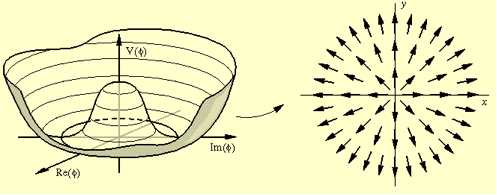
Cosmic strings are associated with models in which the sets of minima are not simply-connected, that is, the vacuum manifold has 'holes' in it. The minimum energy states on the left form a circle and the string corresponds to a non-trivial winding around this. Click for a larger image
Cosmic strings:
These are one-dimensional (that is, line-like) objects which form when an axial or cylindrical symmetry is broken. Strings can be associated with grand unified particle physics models, or they can form at the electroweak scale.
They are very thin and may stretch across the visible Universe. A typical GUT (Grand Unified Theory) string has a thickness that is less then a trillion times smaller that the radius of an Hydrogen atom. Still, a 10 km length of one such string will weigh as much as the Earth itself!
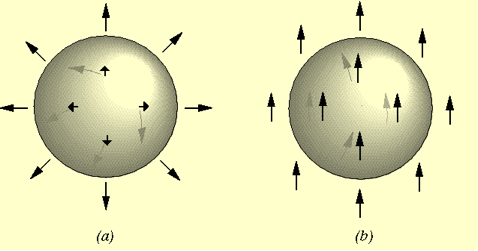
Only the three-dimensional 'hedgehog' configuration on the left corresponds to a monopole
Monopoles:
These are zero-dimensional (point-like) objects which form when a spherical symmetry is broken. Monopoles are predicted to be supermassive and carry magnetic charge. The existence of monopoles is an inevitable prediction of grand unified theories (GUTs); this is one of the puzzles of the standard cosmology.
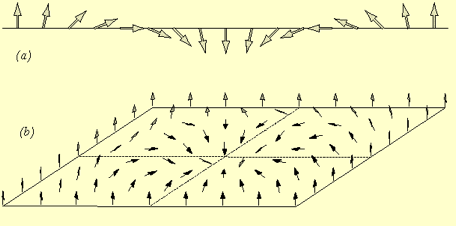
Examples of delocalized texture configurations in one and two dimensions
Textures:
These form when larger, more complicated symmetry groups are completely broken. Textures are delocalized topological defects which are unstable to collapse.
Have they been seen?
Due to their extremely high energies, cosmological defects have not yet been detected, and it is virtually impossible to produce them even in the most powerful particle accelerators. On the other hand, this is one of the reasons why people are interested in them - if they can be found today, they will be a unique direct link to the physics of the first moments of the Universe. Some observational searches are already under way!
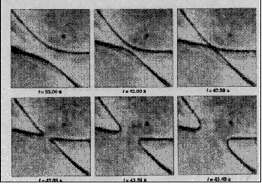
Fig.1: Long-string intercommuting in a liquid crystal. The two strings exchange ends at the crossing
However, defects are not exclusive of the early Universe! They exist and have been studied in a wide variety of more 'down-to-earth' contexts. In the laboratory, topological defects are commonly observed in condensed matter systems. Simple examples are the domains in a ferromagnet; regions in which the magnetic dipoles are aligned, separated by domain walls. Liquid crystals exhibit an array of topological defects, such as strings and monopoles. Defects can also been found in biochemistry, notably in the process of protein folding.
As an example, on the right are two photographs (obtained with an optical microscope) of strings in a nematic liquid crystal (from I.Chuang et. al., 1991).
Why do they form?
If cosmic strings or other topological defects can form at a cosmological phase transition then they will form. This as first pointed out by Kibble and, in a cosmological context, the defect formation process is known as the Kibble mechanism.
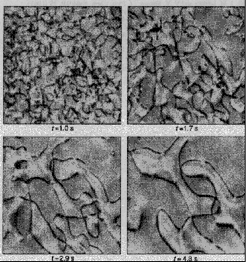
Fig. 2: the evolution of a string network in a liquid crystal. The four snapshots have the same size but were obtained at different times. Notice the progressive dilution of the string network
The simple fact is that causal effects in the early Universe can only propagate (as at any time) as the speed of light c. This means that at a time t, regions of the Universe separated by more than a distance d=ct can know nothing about each other. In a symmetry breaking phase transition, different regions of the Universe will choose to fall into different minima in the set of possible states (this set is known to mathematicians as the vacuum manifold). Topological defects are precisely the 'boundaries' between these regions with different choices of minima, and their formation is therefore an inevitable consequence of the fact that different regions cannot agree on their choices.
For example, in a theory with two minima, plus + and minus -, then neighbouring regions separated by more than ct will tend to fall randomly into the different states (as shown below). Interpolating between these different minima will be a domain wall.
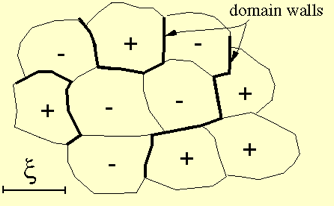
The Kibble mechanism for the formation of domain walls
Cosmic strings will arise in slightly more complicated theories in which the minimum energy states possess 'holes'. The strings will simply correspond to non-trivial 'windings' around these holes (as illustrated below).
Why do we want to study them?
Because, as we pointed out above, they provide a unique link to the physics of the very early Universe. Furthermore, they can crucially affect the evolution of the Universe! So given that they must necessarily form, their study is an unavoidable part of any serious attempt to understand the early Universe.
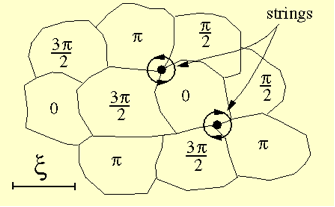
The Kibble mechanism for the formation of cosmic strings
The detailed consequences vary with the type of defect considered. On one hand, domain walls and monopoles are cosmologically catastrophic. Any cosmological model in which they form will evolve in a way that contradicts the basic observational facts that we know about the Universe. Such models must therefore be ruled out!
On the other hand, cosmic strings and (possibly) textures are much more benign. Among other things, they could be the 'seeds' that led to the formation of the large-scale structures we observe today, as well as the anisotropies in the Cosmic Microwave Background. They could also be at the origin of some of the 'dark matter' of the Universe.
However, before one can analyse all these scenarios, one should make sure that one understands how strings evolve. And in order to do this, one must inevitably resort to numerical simulations...
